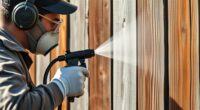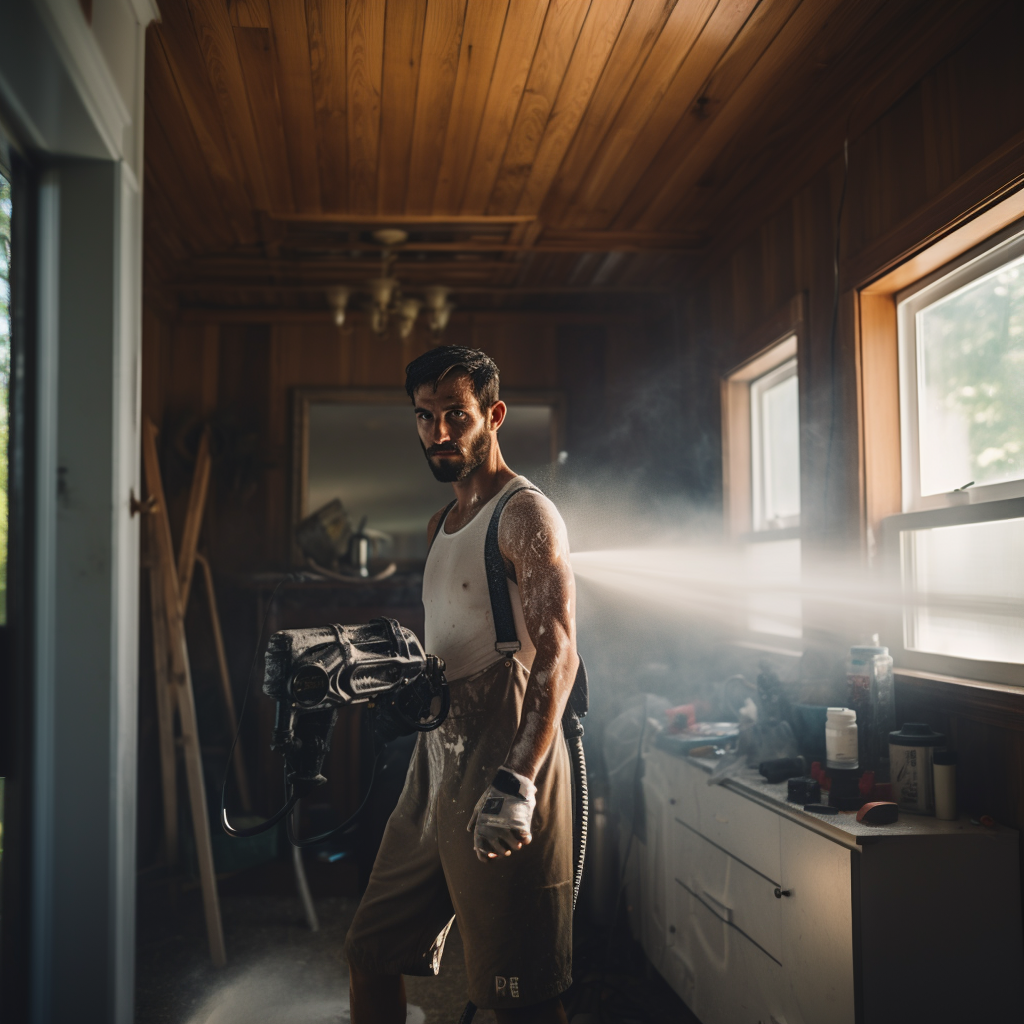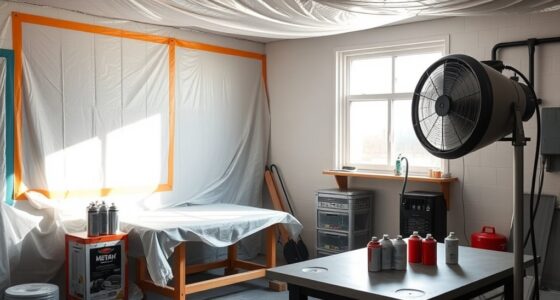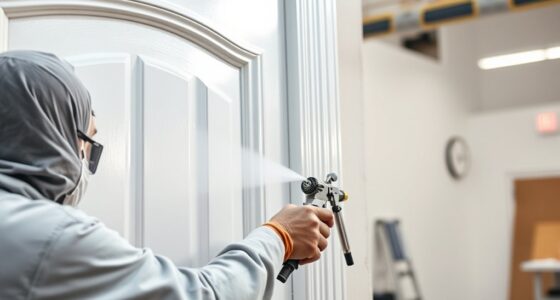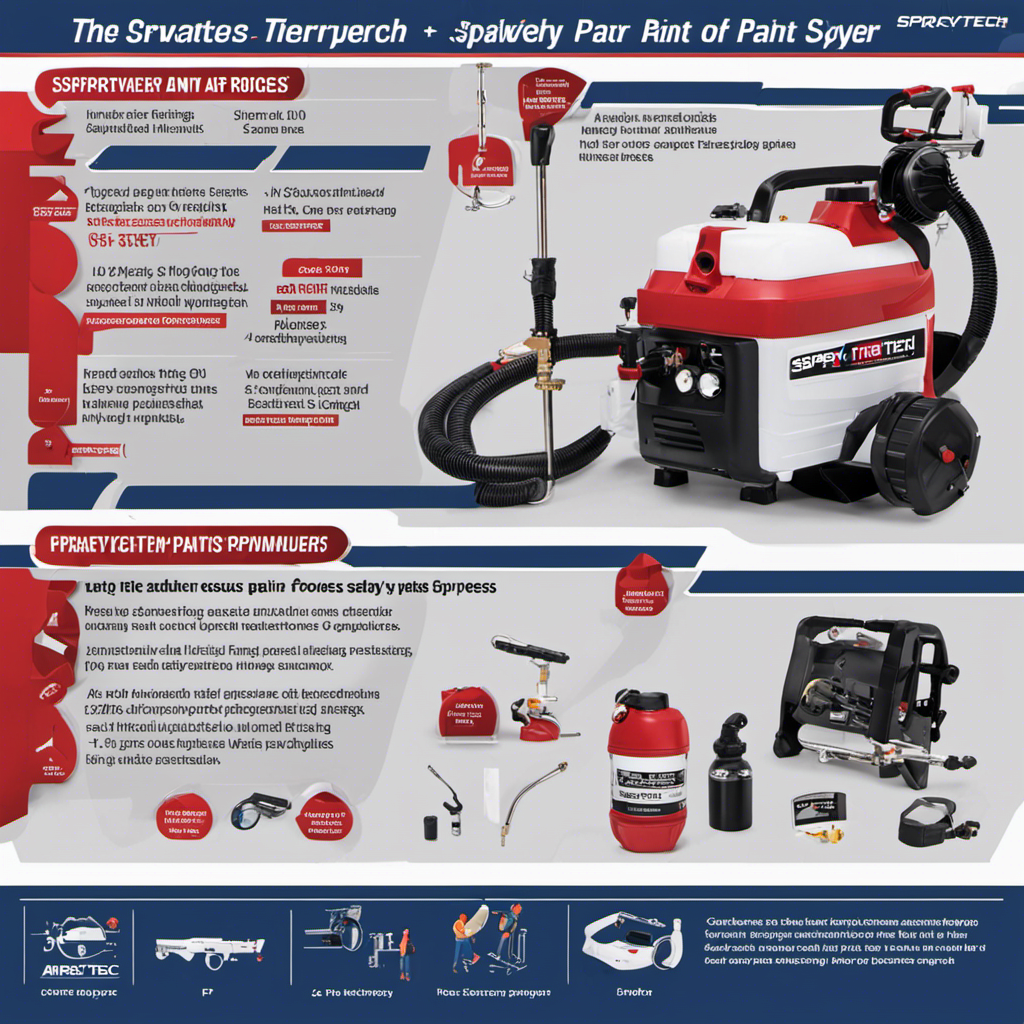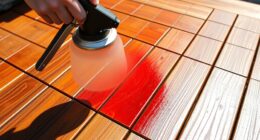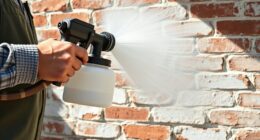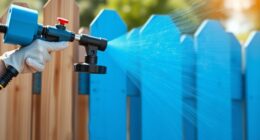To select the right paint and primer for your spray project, match your materials to your surface—oil-based paints and primers work well for durability, while water-based options are versatile and easier to use. Make certain the primer and paint are compatible to prevent peeling or uneven coverage. Consider environmental factors like temperature and humidity, which affect viscosity and application. For best results, choosing appropriate tools and techniques is key—find out more to perfect your project.
Key Takeaways
- Match primer and paint types to your surface (wood, metal, drywall) for optimal adhesion and durability.
- Choose water-based or oil-based paints according to your project needs and sprayer compatibility.
- Adjust paint viscosity based on environmental conditions and sprayer specifications for smooth application.
- Use compatible primers that seal porous surfaces and enhance paint adhesion for a flawless finish.
- Follow manufacturer guidelines for thinning, application techniques, and safety to achieve professional results.
Understanding the Types of Paint Suitable for Sprayers
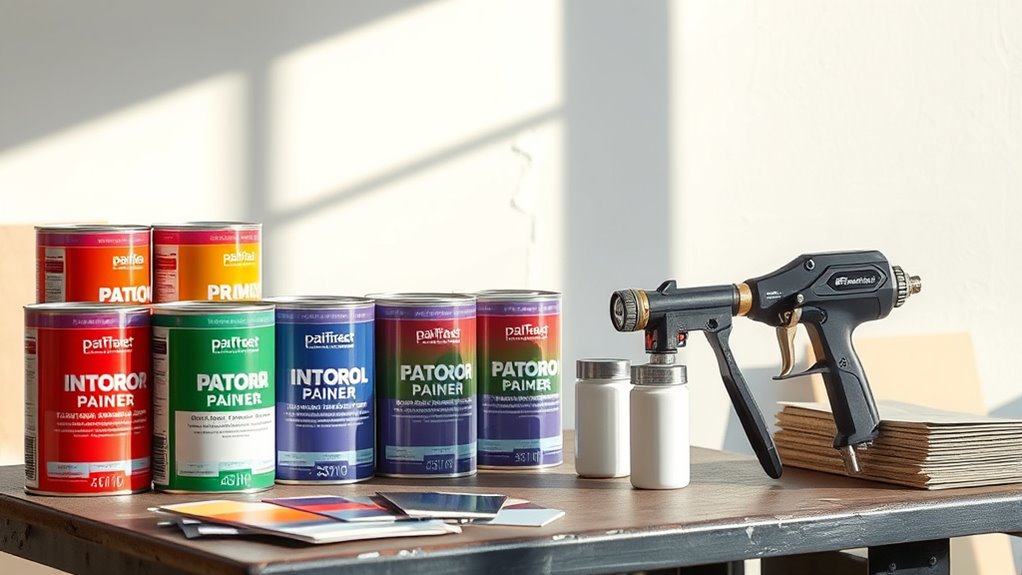
When choosing paint for sprayers, it’s important to understand which types work best for your equipment and project. Different paints have varying viscosities and formulations, impacting how they spray and finish. Oil-based paints tend to provide durability but require specific sprayers and cleanup. Water-based paints are more versatile and easier to work with, especially for beginners. To achieve a smooth finish, you’ll want to master brush techniques for touch-ups or detail work, but spray application should be seamless for large areas. Color matching is also vital; selecting the right type of paint ensures consistency and vibrancy. Understanding paint types and their properties can help you optimize your sprayer’s performance and ensure your project looks professional and polished. Additionally, considering the compatibility with your sprayer can prevent issues such as clogging or uneven application, ultimately saving time and resources. Being aware of the recommended application techniques can further improve the quality of your finish and reduce waste. Knowing the appropriate water-to-paint ratio can also influence the spray pattern and coverage, making your work more efficient.
The Role of Primer in Achieving a Flawless Finish
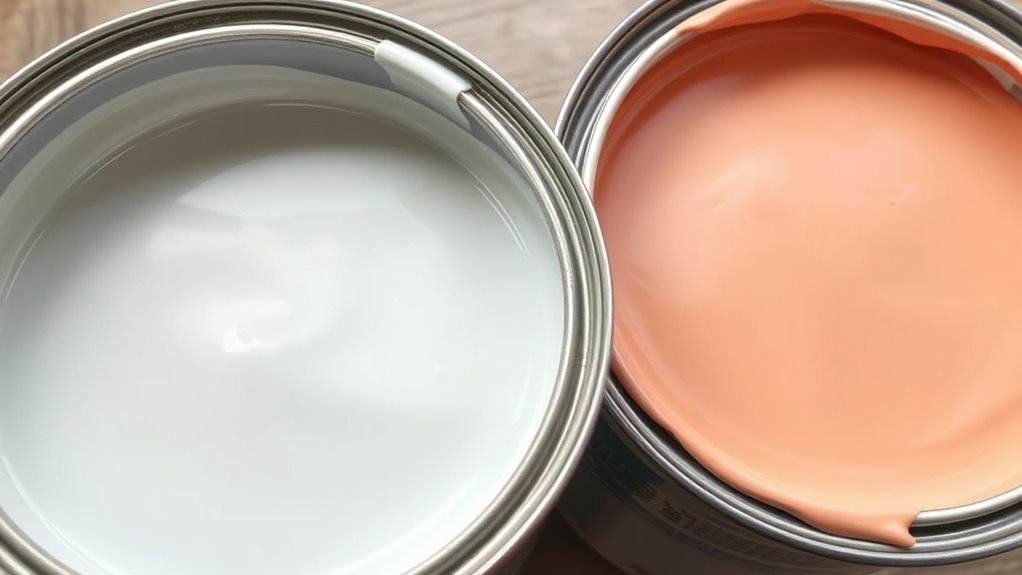
Applying primer is a crucial step in achieving a flawless finish because it prepares the surface, enhances paint adhesion, and hides imperfections. Good primer adhesion ensures your paint bonds strongly, reducing peeling or chipping over time. It also improves paint durability, helping your project withstand wear and tear. To maximize results, consider these factors:
- Select a primer compatible with your surface type and paint.
- Apply an even coat to promote uniform primer adhesion.
- Allow sufficient drying time before applying paint to prevent issues with finish quality.
- Understanding toilet maintenance and repairs can help you choose the appropriate primer for surfaces around bathrooms or areas prone to moisture.
Using the right primer boosts your project’s longevity and creates a smooth, flawless appearance. Skipping or improperly applying primer can lead to uneven color, reduced durability, and a less professional look.
Compatibility Between Paint and Primer for Optimal Results
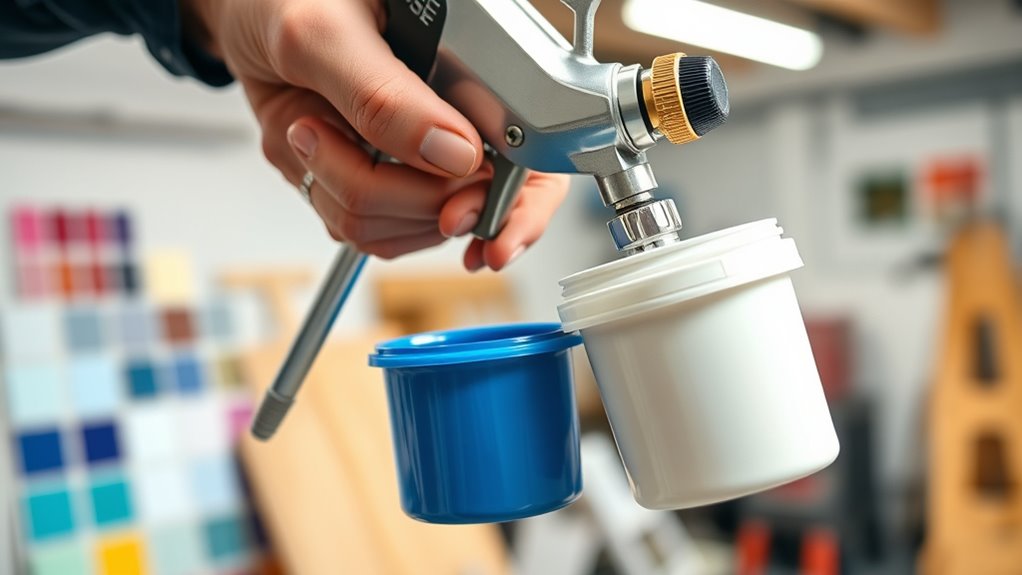
Making sure your paint and primer are compatible is key to a smooth finish. You need to match the right types of paint with the correct primer formulation for the surface you’re working on. When these elements work together, your project will look better and last longer. Additionally, understanding the importance of attention in creative practice can help you stay focused and ensure proper preparation for your painting project. It is also beneficial to be aware of product shelf life, as using expired or improperly stored materials can affect the outcome of your work. Staying informed about automation in business can help you select the best tools and techniques for efficient project completion. Knowing about Kia Tuning options can inspire you to customize your vehicle with the right performance upgrades. Furthermore, considering workspace ergonomics can enhance your comfort and reduce fatigue during lengthy projects.
Compatible Paint Types
Choosing the right paint and primer pair is essential for achieving a smooth, durable finish. When selecting compatible paint types, focus on color matching and paint durability to ensure long-lasting results. Here are key considerations:
- Oil-based primers work best with oil-based paints, providing superior adhesion and durability. Oil-based paints are known for their robustness and resistance to wear, making them ideal for high-traffic areas.
- Latex primers are ideal with water-based paints, offering flexibility and easy clean-up. This compatibility is particularly useful for projects requiring quick turnaround times.
- Bonding primers are versatile and excellent for tricky surfaces, ensuring proper adhesion across various paint types. Proper surface preparation and primer selection can significantly impact the longevity of your finish.
- Using the appropriate primer can also enhance primer effectiveness, helping you achieve a more professional and lasting finish. Selecting the right primer type is especially important when working with surfaces that have been previously painted or are prone to peeling.
Matching paint and primer correctly not only enhances color matching but also boosts overall paint durability. By selecting compatible paint types, you’ll achieve a professional-looking finish that stands the test of time.
Primer Formulation Match
Ensuring the right match between primer formulation and paint type considerably impacts the final finish’s durability and appearance. You need to pay close attention to primer formulation to guarantee it complements your chosen paint. Different formulations, like oil-based or latex primers, work best with specific paint types. Compatibility testing is essential; it helps verify that the primer and paint will adhere properly without issues like peeling or uneven coverage. Always check manufacturer recommendations for compatibility, especially if you’re mixing products from different brands. Testing a small area first can save you time and money by catching potential problems early. Additionally, understanding primer formulation and its compatibility with various paints can help prevent costly mistakes and ensure a professional-looking result. Incorporating knowledge about surface preparation can further improve adhesion and longevity of the finish. Being aware of paint types and their interactions with primers can also influence your choice and overall project success. By selecting the right primer formulation and conducting compatibility testing, you’ll achieve a smoother, longer-lasting finish that enhances your project’s overall quality.
Factors Influencing Paint Viscosity and Sprayer Performance

Your paint’s composition and thickness directly influence how it flows through your sprayer. Temperature and humidity can alter viscosity, making spray application tricky if you’re not careful. Additionally, using the right equipment and nozzle guarantees smooth performance and a professional finish. Incorporating sound vibrations into your preparation routine can further enhance the effectiveness of your application process. Being aware of nutritional advantages of green juice and how they may influence your health can also motivate careful selection of your paint and primer types to ensure optimal results. Recognizing the importance of AI safety measures can inspire you to choose paints and primers that support environmentally sustainable practices, promoting safer working conditions. Moreover, understanding paint viscosity helps in selecting appropriate thinning agents to ensure consistent spray patterns. Regularly monitoring exfoliation benefits can help maintain the health of your skin, which parallels the importance of proper surface preparation in painting projects.
Paint Composition and Thickness
Paint composition and thickness directly impact its viscosity, which in turn affects how smoothly and evenly it flows through a sprayer. Thicker paints require adjustments or thinning, while thinner paints may lead to uneven coverage. Key factors include: 1. Paint additives that modify viscosity and improve flow, ensuring a consistent spray pattern. 2. The use of color matching pigments, which can influence paint density and thickness. 3. The base ingredients, such as latex or oil, determine the overall thickness and drying time. Understanding these elements helps you select a product that sprays efficiently without clogging or drips. Adjusting paint composition with additives ensures ideal performance, while considering thickness aids in achieving a smooth, professional finish. Properly matched paint and primer prevent issues and improve application quality. Additionally, being aware of paint viscosity and how it interacts with your sprayer can help optimize results and reduce troubleshooting during your project. Being mindful of paint consistency can also improve the ease of application and final appearance, especially since paint thickness influences how well the paint coats surfaces and adheres properly. Recognizing the importance of paint flow can further enhance your spraying technique for better coverage. Moreover, understanding paint formulation helps in selecting the right products for different surfaces and environmental conditions, leading to more durable and attractive outcomes.
Temperature and Humidity Effects
Temperature and humidity levels considerably influence paint viscosity and how well it sprays. Temperature effects can cause paint to become too thick or too runny, affecting application quality. Cooler temperatures often increase viscosity, making paint harder to spray smoothly, while higher temperatures can thin it out, risking drips or uneven coverage. Humidity influence also plays a critical role; high humidity can cause paint to dry slowly, leading to runs or sags, whereas low humidity speeds drying, possibly causing brush marks or poor adhesion. When spraying, it’s crucial to monitor both temperature and humidity to maintain ideal paint consistency. Adjusting your technique or waiting for better conditions can ensure a smoother application and a flawless finish. Being aware of these factors helps you achieve professional results.
Equipment and Nozzle Compatibility
Choosing the right equipment and nozzle is essential because they directly affect how paint flows and sprays. Proper nozzle selection ensures your sprayer handles the paint’s viscosity, preventing clogs or uneven coverage. To maximize performance, consider these factors:
- Match the nozzle size to the paint’s viscosity; thicker paints need larger nozzles.
- Regular sprayer maintenance keeps components clean, ensuring consistent spray patterns.
- Use compatible equipment designed for your specific paint type to avoid pressure issues.
Incorrect nozzle selection can lead to poor atomization or overspray, impacting finish quality. Always verify compatibility before starting your project. Proper equipment choice and nozzle maintenance help maintain ideal viscosity flow, making your spraying more efficient and professional-looking.
Selecting the Right Finish and Sheen for Your Project
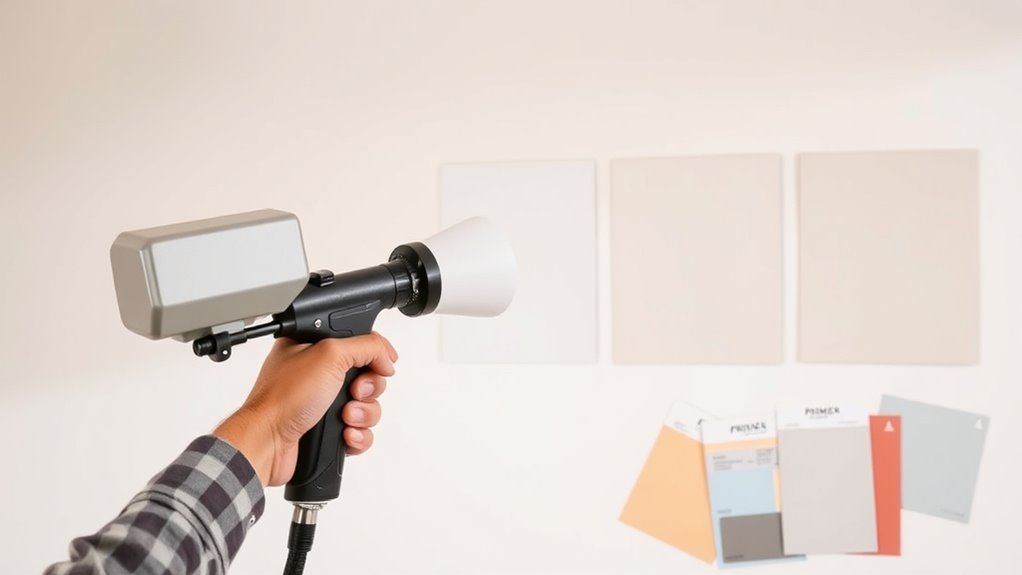
Selecting the right finish and sheen can dramatically influence the look and durability of your project. Your choice affects the overall color palette and enhances the aesthetic appeal of the space. For a subtle, elegant finish, consider a satin or eggshell sheen, which provides a soft glow and hides imperfections. If you want a more vibrant, glossy appearance, opt for a semi-gloss or high-gloss finish, ideal for accents or furniture. Keep in mind that higher sheens tend to be more durable and easier to clean, making them suitable for high-traffic areas. Conversely, matte finishes can soften the room’s look and hide flaws but may require more maintenance. Choosing wisely guarantees your project looks cohesive and stays beautiful over time.
Considering Surface Material and Preparation Needs
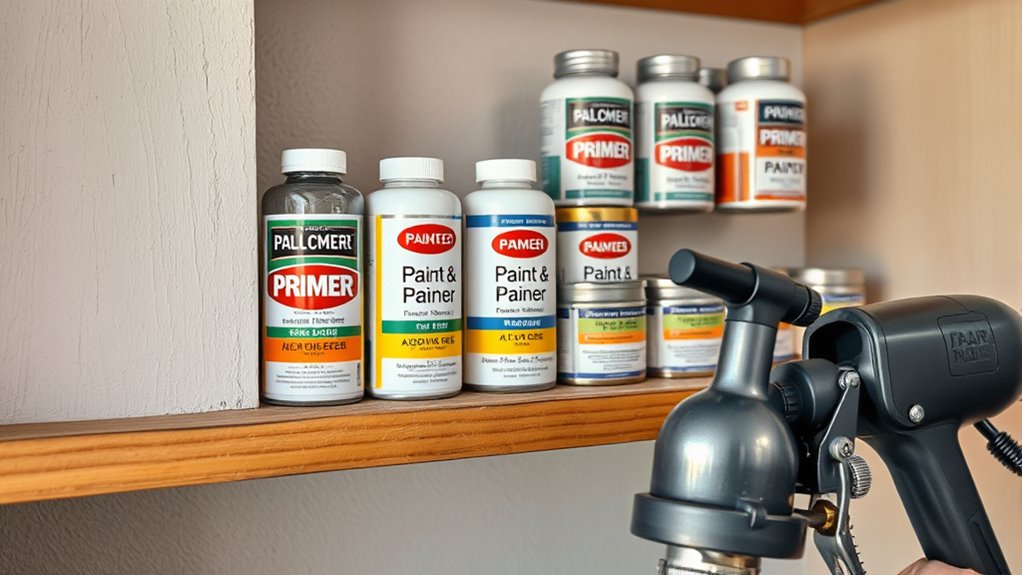
Understanding your surface material is essential because it directly influences the type of primer and paint you should use. Proper surface preparation ensures good adhesion and durability. To achieve this, consider:
- Material Compatibility: Match your primer and paint to the surface—wood, metal, drywall, or concrete—to prevent issues like peeling or uneven coverage.
- Surface Preparation: Clean, sand, or repair the surface as needed to remove dirt, grease, or loose material, creating a smooth, receptive base.
- Assessing Material Porosity: Porous surfaces like unsealed drywall or wood require primers that seal the material before applying paint, ensuring even coverage and better adhesion.
Focusing on these aspects guarantees your project’s success, with long-lasting results.
Environmental Conditions and Their Impact on Painting Projects
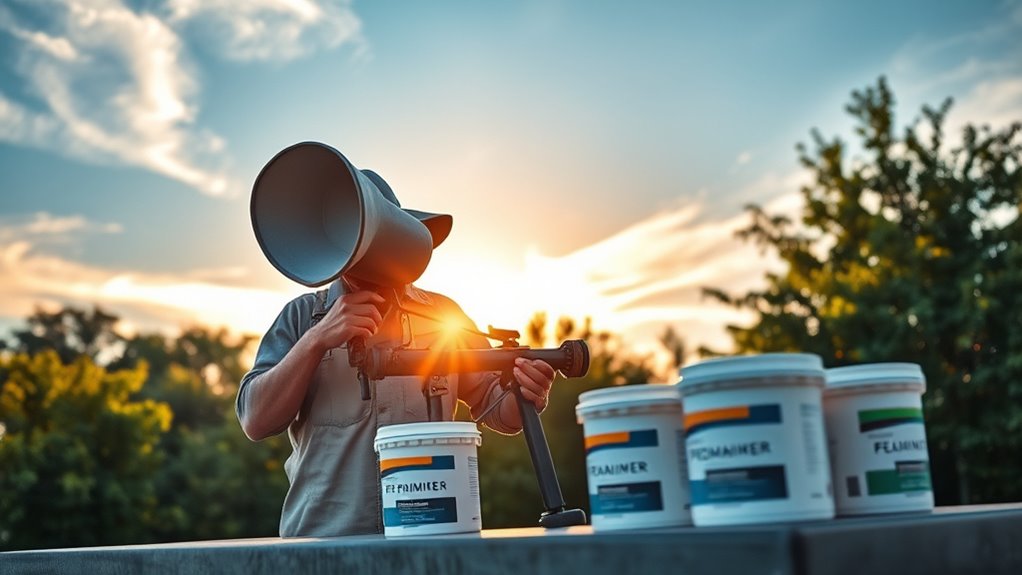
Environmental conditions can profoundly affect the outcome of your painting project. Temperature, humidity, and airflow influence how paint and primer dry and adhere. For example, high humidity can cause eco friendly paints to take longer to cure, while cold temperatures may prevent proper adhesion. Ventilation helps control odors, making odor control strategies essential, especially if you’re working indoors. Guarantee good airflow but avoid rapid drafts that can cause uneven drying or dust settling on wet surfaces. If the weather isn’t ideal, consider delaying your project or using paints formulated for specific conditions. Proper planning around environmental factors helps ensure a smooth application, better durability, and a professional-looking finish. Keep these conditions in mind to optimize your painting results effectively.
Tips for Mixing and Thinning Paint and Primer
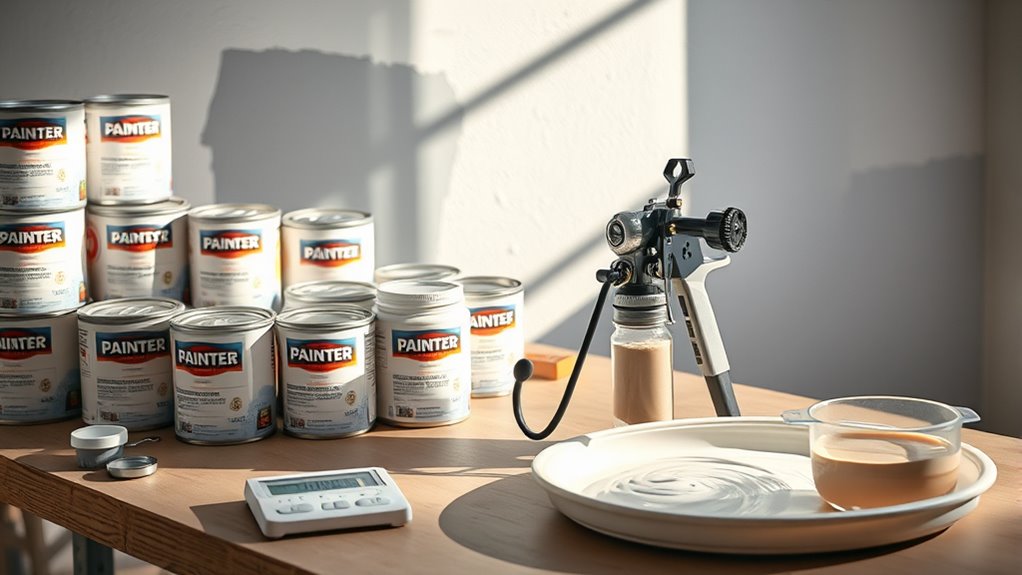
To guarantee a smooth application and a professional finish, it’s essential to mix and thin your paint and primer correctly. Proper thinning ensures consistent flow, prevents clogs, and promotes better color matching with your chosen paint branding. Here are key tips:
Proper thinning guarantees smooth application and a professional finish.
- Follow manufacturer instructions: Always check the label for recommended thinning ratios to maintain color integrity and adhesion.
- Use the right thinning agents: Water for latex paints, or specific solvents for oil-based paints, to achieve ideal viscosity.
- Test and adjust: Thin small amounts first, then test spray on a scrap surface. Adjust as needed for smooth, even coverage without runs or splatters.
These steps help you maintain color accuracy and ensure your paint sprayer performs at its best.
Troubleshooting Common Issues During Spray Painting

Even with proper mixing and thinning, spray painting can present challenges that affect your results. Common issues include uneven coverage, drips, or overspray. To troubleshoot, check your spray distance and speed—holding the gun too close or moving too fast can cause uneven application. Adjust your brush techniques to maintain a consistent distance and steady motion. Always follow safety precautions, like wearing a mask and protective goggles, to prevent inhaling fumes or getting paint in your eyes. If you notice drips, reduce your pressure or slow your movement. For overspray, adjust your spray pattern or use masking tape to protect surrounding surfaces. Staying mindful of these tips helps you troubleshoot issues effectively, ensuring a smooth, professional finish.
Frequently Asked Questions
How Do I Store Leftover Paint and Primer Safely?
To store leftover paint and primer safely, first check the paint container labels for specific instructions. Seal the containers tightly to prevent leaks and store them upright in a cool, dry place away from heat sources. Label the containers clearly. If you can’t reuse the leftovers, follow proper disposal methods to avoid environmental harm. This way, you guarantee safety and preservation for future touch-ups or projects.
Can I Mix Different Brands of Paint and Primer?
Ever notice how sometimes mixing your favorite snacks leads to surprisingly good results? Well, the same applies to paint and primer! You can mix different brands if they’re compatible, but it’s best to verify brand compatibility first. Use proper mixing techniques to ensure a smooth blend. Keep in mind, incompatible brands might cause issues like poor adhesion or uneven finish, so double-check before combining them.
What Safety Precautions Should I Take During Spray Painting?
When spray painting, you should always prioritize safety. Make sure you have proper ventilation to avoid inhaling fumes and keep your workspace well-ventilated. Wear protective gear like a mask, goggles, and gloves to prevent skin and eye irritation. Keep fire extinguishers nearby and work in a well-ventilated area to minimize risks. Taking these precautions helps guarantee your project is safe, efficient, and successful.
How Do Weather Changes Affect Paint Drying Times?
Weather changes can turn your painting experience into a dance with nature. Humidity impact slows the drying process, making paint feel like it’s taking a leisurely stroll to set. Temperature effects also play a role; cooler air prolongs drying, while warm weather speeds it up. Keep an eye on the forecast, as these factors influence how smoothly your project progresses. Adjust your timing accordingly for the best results.
Are Eco-Friendly Paints Compatible With All Sprayers?
You might wonder if eco-friendly paints work with your sprayer. Generally, eco-friendly compatibility depends on your sprayer types and paint formulations. Most modern sprayers can handle water-based or low-VOC paints, but some, like airless sprayers, may need adjustments or specific tips. Always check the manufacturer’s guidelines to verify your sprayer is suitable for eco-friendly paints, and test a small area first to avoid clogs or uneven application.
Conclusion
Choosing the right paint and primer is like preparing a flawless foundation for a masterpiece. When you match the right materials and consider your surface and environment, your spray project becomes smoother and more successful. I once watched a novice painter struggle with drips, only to realize they’d chosen the wrong primer—like trying to build a house on shaky ground. Get your materials right, and your finish will be nothing short of art.
Franz came aboard the Paint Sprayer Zone team with a background in both journalism and home renovation. His articulate writing style, combined with a passion for DIY projects, makes him an invaluable asset. Franz has a knack for breaking down technical jargon into easy-to-understand content, ensuring that even the most novice of readers can grasp the complexities of paint sprayers.

